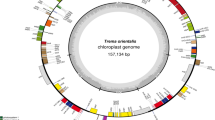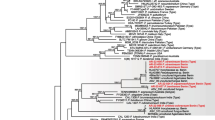Abstract
Among the 23 genera belonging to the Heptapteridae family, Pimelodella stands out with the largest number of species, totaling 82 valid ones. Despite the few species characterized cytogenetically, this genus exhibits considerable variation in chromosomal markers. Thus, this study consists in a cytogenetic characterization of Pimelodella cristata collected in the Central Amazon region, contributing with new cytogenetic data for the genus. This species presented 2n (diploid number) = 46 (22 metacentric + 18 submetacentric + 2 subtelocentric + 4 acrocentric) and nucleolus organizing regions (NORs) coincident with the secondary constriction in the short arm of the acrocentric pair 22. In this same region, rich GC sites were also detected, as well as sequences of 18S ribosomal DNA (18S rDNA) through fluorescence in situ hybridization (FISH), confirming the pattern of simple NORs. Multiple sites of 5S ribosomal DNA (5S rDNA) were observed, totaling four terminal sites on metacentric chromosomes. P. cristata did not follow the heterochromatin distribution pattern frequently reported in the genus, revealing a larger amount of heterochromatin and some interstitial blocks. In addition to the cytogenetic characterization of one population of P. cristata from the Central Amazon region, this study brings a discussion about the main mechanisms related to the karyotypic variability of the genus, based on data available of Pimelodella in the literature associated with the geographic distribution of its species.



Similar content being viewed by others
Availability of data and material
all specimens analyzed in this study was deposited on the Ichthyological colletion of Museu de Zoologia da Universidade Estadual de Londrina (MZUEL). The vouchers numbers are available online in specieslink platform.
Code Availability
Not applicable.
Change history
04 April 2022
A Correction to this paper has been published: https://doi.org/10.1007/s11756-022-01085-9
Abbreviations
- 2n:
-
diploid number.
- 5S rDNA:
-
5S ribosomal DNA.
- 18S rDNA:
-
18S ribosomal DNA.
- a:
-
acrocentric.
- Ag-NOR:
-
nucleolus organizing region stained with silver nitrate.
- Avidin-FITC:
-
avidin-fluorescein isothiocyanate.
- CAPES:
-
Coordenação de Aperfeiçoamento de Pessoal de Nível Superior–Brasil.
- CMA3 :
-
chromomycin A3.
- Cy3-AP3-dUTP:
-
5-amino-propargyl-2’-deoxyuridine-5’-triphosphate conjugated with cyanine.
- DAPI:
-
4’, 6-diamidino2-phenylindole.
- Fig:
-
figure.
- FISH:
-
fluorescence in situ hybridization.
- FN:
-
fundamental number.
- IBAMA:
-
Instituto Brasileiro do Meio Ambiente e dos Recursos Naturais Renováveis.
- m:
-
metacentric.
- Mini-Prep:
-
mini-preparation.
- MZUEL:
-
Museu de Zoologia da Universidade Estadual de Londrina.
- NORs:
-
nucleolus organizing regions.
- PCR:
-
polymerase chain reaction.
- PEG:
-
polyethylene glycol.
- SISBIO:
-
Sistema de Autorização e Informação em Biodiversidade.
- sm:
-
submetacentric.
- st:
-
subtelocentric.
References
Almeida-Toledo LF, Foresti F, Trajano E, Almeida Toledo Filho S (1992) Cytogenetic analysis of the Brazilian blind catfish Pimelodella kronei and its presumed ancestor. P transitoria Caryologia 45:255–262. https://doi.org/10.1080/00087114.1992.10797229
Almeida-Toledo LF, Ozouf-Costaz C, Foresti F, Bonillo C, Porto-Foresti F, Daniel-Silva MFZ (2002) Conservation of the 5S-bearing chromosome pair and co-localization with major rDNA clusters in five species of Astyanax (Pisces, Characidae). Cytogenet. Genome Res 97:229–233. https://doi.org/10.1159/000066609
Barbosa LM, Ferreira GEB, Prizon AC, Portela-Castro ALB, Martins-Santos IC (2015) Cytogenetic characterization of species of the family Heptapteridae (Teleostei: Siluriformes) from the Cuiabá and Ivaí River Basins, Brazil. Genet mol res 14:8640–8649. https://doi.org/10.4238/2015.July.31.12
Bertollo LAC, Takahashi CS, Moreira-Filho O (1978) Cytotaxonomic considerations on Hoplias lacerdae (Pisces, Erythrinidae). Braz J Genet 1:103–120
Bitencourt JA, Affonso PRAM, Giuliano-Caetano L, Dias AL (2011) Identification of distinct evolutionary units in allopatric populations of Hypostomus cf. wuchereri Günther, 1864 (Siluriformes: Loricariidae): karyotypic evidence. Neotrop Ichthyol 9:317–324. https://doi.org/10.1590/S1679-62252011000200008
Bockmann FA, Slobodian V (2013) Heptapteridae. In: Queiroz LJ, Torrente-Vilara G, Ohara WM, Silva THP, Zuanon J, Doria CRC (eds) Peixes do Rio Madeira, vol 3. Dialeto, São Paulo, pp 12–71
Bockmann FA, Slobodian V (2017) Family Heptapteridae - three-barbeled catfishes. In: Van der Sleen P, Albert JS (eds) Field guide to the fishes of the Amazon, Orinoco, and Guianas. Princeton University Press, New Jersey, pp 233–254
Borba RS, Silva EL, Pacheco ACS, Parise-Maltempi PP, Alves AL (2012) Trends in the karyotypic evolution of the Neotropical catfish Family Heptapteridae Bockmann 1998 (Teleostei: Siluriformes). Rev Fish Biol Fish 22:509–518. https://doi.org/10.1007/s11160-011-9245-3
Conde-Saldaña CC, Barreto CAV, Villa-Navarro FA, Dergam JA (2017) An Unusual Accumulation of Ribosomal Multigene Families and Microsatellite DNAs in the XX/XY Sex Chromosome System in the Trans-Andean Catfish Pimelodella cf. chagresi (Siluriformes: Heptapteridae). Zebrafish 15:55–62. https://doi.org/10.1089/zeb.2017.1469
Conde-Saldaña CC, Albornoz-Garzon JG, Garcia-Melo JE, Dergam J, Villa-Navarro FA (2019) A new species of Pimelodella Eigenmann and Eigenmann, 1888 (Siluriformes: Heptapteridae) from the Sierra Nevada de Santa Marta, Colombia. Zootaxa 4668:562–574. https://doi.org/10.11646/zootaxa.4668.4.8
Dazzani B, Garcia C, Peixoto M, Trajano E, Almeida-Toledo LFD (2012) Cytogenetic and molecular analyses in troglobitic and epigean species of Pimelodella (Siluriformes: Heptapteridae) from Brazil. Neotrop Ichthyol 10:623–632. https://doi.org/10.1590/S1679-62252012005000020
Dias AL, Foresti F (1993) Cytogenetic studies on fishes of the family Pimelodidae (Siluroidei). Rev Bras Genet 16:585–600. http://hdl.handle.net/11449/37710
Fernandes CA, Damásio JF, Guterres ZR, Abelha MCF (2013) Cytogenetic Studies in Two Species of Genus Pimelodella (Teleostei, Siluriformes, Heptapteridae) from Iguatemi River Basin, Brazil. Cytologia 78:91–95. https://doi.org/10.1508/cytologia.78.91
Ferraris CJ Jr (2007) Checklist of catfishes, recente and fóssil (Osteichthyes: Siluriformes), and catalogue of siluriform primary types. Zootaxa 1418:1–628. https://doi.org/10.11646/zootaxa.1418.1.1
Ferreira M, Bressane KCO, Moresco ARC, Moreira-Filho O, Almeida-Toledo LF, Garcia C (2014) Comparative application of direct sequencing, PCR-RFLP, and cytogenetic markers in the genetic characterization of Pimelodus (Siluriformes: Pimelodidae) species: Possible implications for fish conservation Genet. Mol Res 13:4529–4544. https://doi.org/10.4238/2014.June.17.5
Fricke R, Eschmeyer WN, Fong JD (2021a) ESCHMEYER’S CATALOG OF FISHES: GENERA/SPECIES BY FAMILY/SUBFAMILY, http://researcharchive.calacademy.org/research/ichthyology/catalog/SpeciesByFamily.asp (November 23, 2021)
Fricke R, Eschmeyer WN, Van der Laan R (eds) (2021b) ESCHMEYER’S CATALOG OF FISHES: GENERA, SPECIES, REFERENCES, http://researcharchive.calacademy.org/research/ichthyology/catalog/fishcatmain.asp (February 11, 2021)
Garcia C, Almeida-Toledo LF (2010) Comparative chromosomal analyses in species of the genus Pimelodella (Siluriformes, Heptapteridae): occurrence of structural and numerical polymorphisms. Caryologia 63:32–40. https://doi.org/10.1080/00087114.2010.10589706
Gouveia JG, Moraes VPO, Sampaio TR, Rosa R, Dias AL (2013) Considerations on karyotype evolution in the genera Imparfinis Eigenmann and Norris 1900 and Pimelodella Eigenmann and Eigenmann 1888 (Siluriformes: Heptapteridae). Rev. Fish Biol. Fish. 23:215–227. https://doi.org/10.1007/s11160-012-9286-2
Gouveia JG, Moraes-Manécolo VPO, Swarça AC, Fenocchio AS, Giuliano-Caetano L, Dias AL (2018) Cytogenetic Trends in Two Families of the Neotropical Catfishes: Heptapteridae and Pseudopimelodidae (Siluriformes). Zebrafish 15:629–641. https://doi.org/10.1089/zeb.2018.1577
Hatanaka T, Galetti PM Jr (2004) Mapping of the 18S and 5S ribosomal RNA genes in the fish Prochilodus argenteus Agassiz, 1829 (Characiformes, Prochilodontidae). Genetica 122:239–244. https://doi.org/10.1007/s10709-004-2039-y
Howell WM, Black DA (1980) Controlled silver-staining of nucleolus organizer regions with a protective colloidal developer: a 1-step method. Cell Mol Life Sci 36:1014–1015
Kantek DLZ, Peres WAM, Moreira-Filho O (2015) Cytogenetic study of heptapterids (Teleostei, Siluriformes) with particular respect to the Nemuroglanis subclade. Comp Cytogenet 9:17–29. https://doi.org/10.3897/CompCytogen.v9i1.8488
Knowles LL, Carstens BC (2007) Delimiting species without monophyletic gene trees. Syst Biol 56:887–895. https://doi.org/10.1080/10635150701701091
Levan A, Fredga K, Sandberg AA (1964) Nomenclature for centromeric position on chromosomes. Hereditas 52:201–220. https://doi.org/10.1111/j.1601-5223.1964.tb01953.x
Lui RL, Blanco DR, Moreira-Filho O, Margarido VP (2012) Propidium iodide for making heterochromatin more evident in the C-banding technique. Biotech Histochem 87:433–438. https://doi.org/10.3109/10520295.2012.696700
Martins C, Galetti PM Jr (1999) Chromosomal localization of 5S rDNA genes in Leporinus fish (Anostomidae, Characiformes). Chromosome Res 7:363–367. https://doi.org/10.1023/A:1009216030316
Molina WF, Alves DEO, Araújo WC, Martinez PA, Silva MFM, Costa GWWF (2010) Performance of human immunostimulating agents in the improvement of fish cytogenetic preparations. Genet Mol Res 9:1807–1814. https://doi.org/10.4238/vol9-3gmr840
Moraes-Manécolo VPO (2014) Citogenetica convencional e molecular de diferentes espécies dos gêneros Heptapterus, Rhamdella e Pimelodella. Siluriformes, Heptapteridae) de duas bacias hidrográficas do Rio Grande do Sul. Tese (Doutorado em Genética e Biologia Molecular). Universidade Estadual de Londrina
Padial JM, De La Riva I (2010) A response to recent proposals for integrative taxonomy. Biol J Linn Soc Lond 101:747–756. https://doi.org/10.1111/j.1095-8312.2010.01528.x
Pazza R, Kavalco SAF, Penteado PR, Kavalco KF, Almeida-Toledo LF (2008) The species complex Astyanax fasciatus Cuvier (Teleostei, Characiformes) – a multidisciplinary approach. J Fish Biol 72:2002–2010. https://doi.org/10.1111/j.1095-8649.2008.01837.x
Sambrook J, Fritsch EF, Maniatis T (1989) Molecular cloning: a laboratory manual, second edn. Cold spring harbor laboratory press, New York
Schwarzacher T, Heslop-Harrison JS (2000) Comparative genome organization in plants: from sequence and markers to chromatin and chromosomes. Plant Cell 12:617–635. https://doi.org/10.1105/tpc.12.5.617
Schweizer D (1980) Simultaneous fluorescent staining of R-bands and specific heterochromatic regions (DA-DAPI bands) in human chromosomes. Cytogenet Genome Res 27:190–193. https://doi.org/10.1159/000131482
Slobodian V (2017) Taxonomic revision of Pimelodella Eigenmann and Eigenmann, 1888 (Siluriformes: Heptapteridae): an integrative proposal to delimit species using a multidisciplinary strategy. Tese (Doutorado em Sistemática, Taxonomia e Biodiversidade), Universidade de São Paulo
Slobodian V, Akama A, Dutra GM (2017) A new species of Pimelodella (Siluriformes: Heptapteridae) from the Guiana Shield, Brazil. Zootaxa 4338:085–100. https://doi.org/10.11646/zootaxa.4338.1.4
Slobodian V, Pastana MNL (2018) Description of a new Pimelodella (Siluriformes: Heptapteridae) species with a discussion on the upper pectoral girdle homology of Siluriformes. J Fish Biol 93:901–916. https://doi.org/10.1111/jfb.13795
Souza-Shibatta L, Pezenti LF, Ferreira DG, Almeida FS, Sofia SH, Shibatta OA (2013) Cryptic species of the genus Pimelodella (Siluriformes: Heptapteridae) from the Miranda River, Paraguay River basin, Pantanal of Mato Grosso do Sul, Central Brazil. Neotrop ichthyol 11:101–109. https://doi.org/10.1590/S1679-62252013000100012
Sumner AT (1972) A simple technique for demonstrating centromeric heterochromatin. Exp Cell Res 75:304–306. https://doi.org/10.1016/0014-4827(72)90558-7
Swarça AC, Vidotto AP, Dias AL (2003) Cytogenetic characterization of Pimelodella aff. avanhandavae (Siluriformes, Pimelodidae) from Tibagi River (Paraná State, Brazil). Caryologia 56:421–425. https://doi.org/10.1080/00087114.2003.10589353
Toledo V, Ferrari I (1976) Estudo citogenético de Pimelodella sp. e Rhamdia hilarii (Pimelodinae, Pimelodidae, Pisces): Cromossomo marcador. Científica 4:120–123
Trajano E, Secutti S, Mattox GMT (2009) Epigean and subterranean ichthyofauna in Cordisburgo karst area, eastern Brazil. Biota Neotrop 9:277–281. https://doi.org/10.1590/S1676-06032009000300026
Vasconcelos C, Martins-Santos IC (2000) Chromosome polymorphism in species of the Pimelodidae family (Pisces, Siluriformes). Hereditas 132:103–109. https://doi.org/10.1111/j.1601-5223.2000.00103.x
Vidotto AP, Swarça AC, Fenocchio AS, Dias AL (2004) Cytogenetic studies in three Pimelodella meeki populations (Pisces, Pimelodidae) from Tibagi river basin (Brazil). J Hered 95:517–520. https://doi.org/10.1093/jhered/esh075
Vissotto PC, Foresti F, Oliveira C (1999) Karyotype description of five species of Pimelodidae (Teleostei, Siluriformes). Chromosome Sci 3:1–7
Acknowledgements
The authors thank Dr. Jansen Alfredo Sampaio Zuanon (INPA), Dra. Lucia Helena Rapp Pydaniel (INPA) and Dr. José Luis Olivan Birindelli (UEL) for the identification of individuals and Mr. Patrik Viana for their assistance with sample collection. This research was supported by a grant from Coordenação de Aperfeiçoamento de Pessoal de Nível Superior-Brazil (CAPES) - Finance code 001. They also thank designer Angela Takagui Ferreira for her contribution to the illustrative image of P. cristata.
Funding
Coordenação de Aperfeiçoamento de Pessoal de Nível Superior – Brasil (CAPES).
Author information
Authors and Affiliations
Contributions
MCT Designed the study, performed the experiments, and drafted the manuscript. FHT collected the specimens and performed some classical cytogenetic analyzis; JNCB, MCCL performed some FISH experiments and drafted the manuscript. ALD and EF, provides laboratorial structure and revised the manuscript. All authors read and approved the final version of the manuscript.
Corresponding author
Ethics declarations
Financial interests and Non-financial interests
The authors declare that they have no financial or non-financial interests.
Conflict of interest
The authors declare that there is no conflict of interest that could be perceived as prejudicial to the impartiality of the reported research.
Additional information
Publisher’s Note
Springer Nature remains neutral with regard to jurisdictional claims in published maps and institutional affiliations.
Rights and permissions
About this article
Cite this article
Terra, M.C., Takagui, F.H., Baldissera, J.N.D.C. et al. The karyotype of Pimelodella cristata (Siluriformes: Heptapteridae) from Central Amazon basin: with a discussion of the chromosome variability in Pimelodella. Biologia 77, 1995–2003 (2022). https://doi.org/10.1007/s11756-022-01056-0
Received:
Accepted:
Published:
Issue Date:
DOI: https://doi.org/10.1007/s11756-022-01056-0




